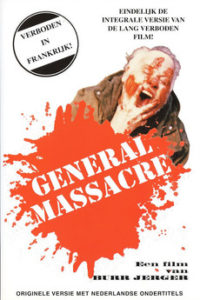 A Belgian-American co-production from 1973 that makes a fumbled attempt at artsploitation in the guise of a hard-hitting anti-war statement. A one-man show by writer/producer/director/star Burr Jerger, the film contains a number of shocking and exploitive scenes, yet it’s quite dull overall.
A Belgian-American co-production from 1973 that makes a fumbled attempt at artsploitation in the guise of a hard-hitting anti-war statement. A one-man show by writer/producer/director/star Burr Jerger, the film contains a number of shocking and exploitive scenes, yet it’s quite dull overall.
The clumsy opening sequence takes place in Belgium, circa 1945: General Massacre, an aptly monikered American tank commander tasked with rooting out Nazis, happens upon a mansion located in a forest. Spotting a naked woman cavorting inside, he enters the house, which turns out to be decorated with Nazi memorabilia, and eagerly canoodles with the gal. Cut to 1954, when the general freaks out upon finding the woman, who’s now his wife, with another man; he chases her into the forest and guns her down.
Cut to 1970, when General Massacre, now a considerably older Colonel Sanders lookalike, and a veteran of the Korean and Vietnam wars, returns to the Belgian forest mansion, which is now his home, after being interrogated by a military tribunal. Said tribunal is set up to investigate a civilian massacre presided over by General Massacre, who spews a lot of hateful and racist rhetoric on the stand while arguing about the greatness of war.
Massacre’s twentyish daughter Kate, who’s been living in the mansion, picks him and his companion, one Corporal Tsai, up at the train station. Back home Massacre finds himself haunted by the horse-riding specter of his deceased wife. He takes to drinking excessively, playing late night piano solos and staging elaborate war games in the forest surrounding his house. During one of these “games” Massacre and Tsai kill a cow, which Tsai eagerly films. Later that night Massacre screens the footage of the killing for Kate, who is understandably disgusted.
The following day General Massacre’s next door neighbor, an extremely chatty young woman, enters his house and is accosted by the general. Following more boredom (for the general and the audience) Massacre has sex with Kate. The relationship between the two, however, quickly degenerates as General Massacre goes progressively nuttier…
This film’s few good moments are provided by the forest scenery, which makes for a deceptively lush and suitably atmospheric backdrop. The film is totally undistinguished otherwise, packed with distracting 1970s flourishes (zooms, pastoral montages, compulsive intercutting, iris shots) that muddle an otherwise simple and uncluttered narrative. The acting, including that of Mr. Jerger, ranges from inept to downright horrendous, and the political symbolism is on the overbaked side: just in case we don’t get the point, American flags are prominently displayed throughout the film.
GENERAL MASSACRE has become notorious for a real-life cow killing that occurs around the midway point. That killing is indeed pretty damn ugly, with the cow’s death throes replayed twice (which got the film banned in several European countries). For good measure, a couple of ducks are also killed in a later scene that unlike the cow shooting is only played once, but comes complete with extreme close-ups of the ducks’ eyes as they die.
To be sure, there were a number of cult oddities from the late 1960s and ‘70s that conveyed the awfulness of war and the psychosis it produced, including THE LONG DAY’S DYING, SAVE THE TIGER and THE NOAH. GENERAL MASSACRE does not deserve to be ranked among them!
Vital Statistics
GENERAL MASSACRE
Burr Jerger Productions
Director/Producer: Burr Jerger
Screenplay: Burr Jerger, Herman Wuyts
Cinematography/Editing: Herman Wuyts
Cast: Burr Jerger, Christine Gish, Tiffany Tate, Tsai, Al Grundy, Guy Williams
